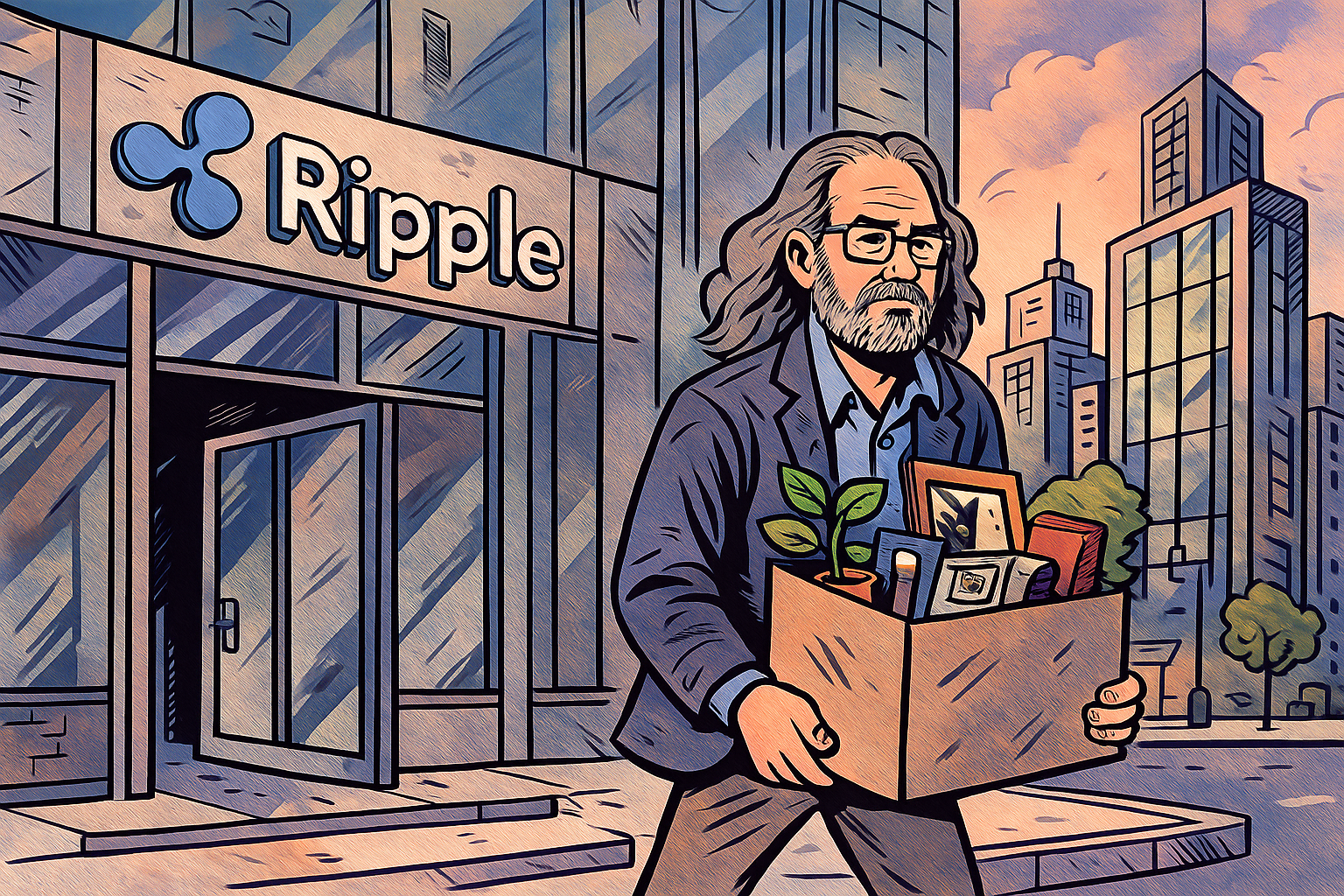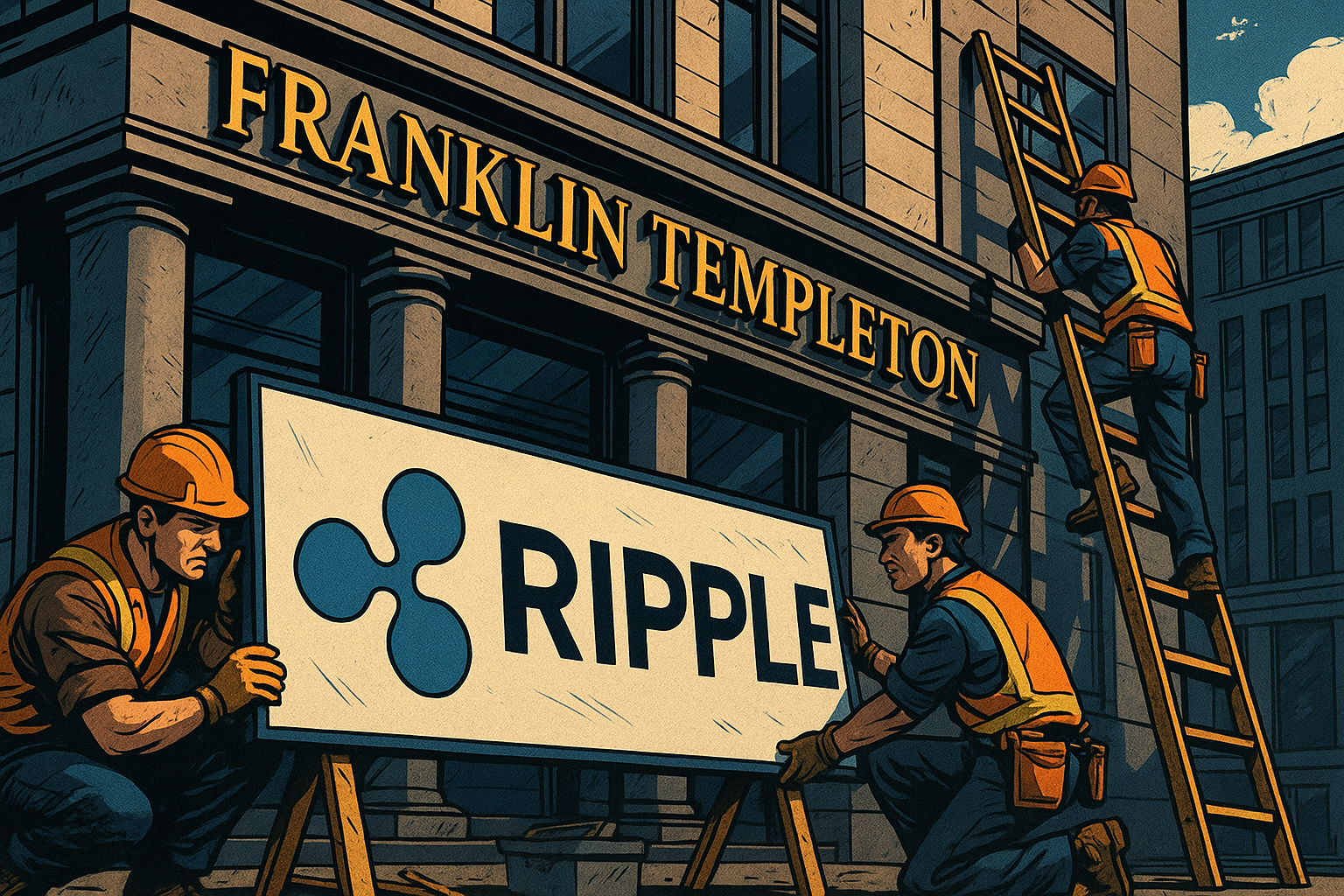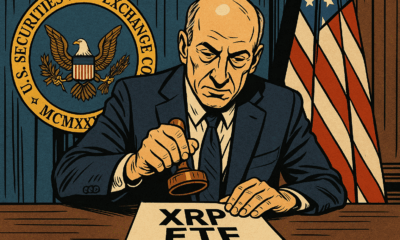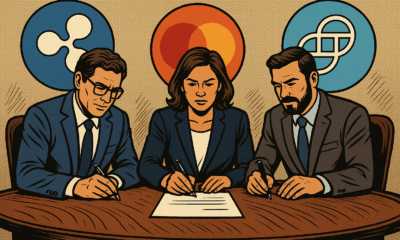Ripple
Ripple CTO David “JoelKatz” Schwartz to Step Down by Year’s End, but Will Remain on Board

- Share
- Tweet /data/web/virtuals/383272/virtual/www/domains/theunhashed.com/wp-content/plugins/mvp-social-buttons/mvp-social-buttons.php on line 63
https://theunhashed.com/wp-content/uploads/2025/10/joel-1000x600.png&description=Ripple CTO David “JoelKatz” Schwartz to Step Down by Year’s End, but Will Remain on Board', 'pinterestShare', 'width=750,height=350'); return false;" title="Pin This Post">
In a surprise move that signals a turning of the guard, David “JoelKatz” Schwartz — the longtime CTO and technical architect behind XRP’s ledger — announced he will step down from his executive role at Ripple by the end of 2025. Yet, his exit from day‑to‑day operations comes with strings attached: he’s not leaving entirely, and his continuing presence suggests this is less an abdication than a recalibration.
A Quiet Separation, Not a Break
Schwartz’s announcement, made via a post on X (formerly Twitter), explained that after more than 13 years with Ripple, he plans to shift focus toward family, personal projects, and rediscovering passions which fell by the wayside during his intense involvement in cryptocurrency development.
Despite relinquishing the CTO title, Schwartz will take on the role of CTO Emeritus and join Ripple’s board of directors. In those capacities, he intends to remain connected to the firm and its mission — providing guidance, advising on technical direction, and acting as a bridge to the XRP community.
According to Ripple CEO Brad Garlinghouse, this change was mutually agreed upon, and he welcomed Schwartz’s continuing influence: “regular check‑ins will continue,” Garlinghouse wrote in his own post.
The Context: Litigation Resolved, Transition Begins
Schwartz’s decision comes at a pivotal moment for Ripple. The company has just closed the book on its long-standing legal battle with the U.S. Securities and Exchange Commission (SEC), which culminated in a settlement in August 2025 involving alleged unregistered sales of XRP. That settlement marked a milestone in regulatory clarity and freed Ripple from years of uncertainty and litigation overhead.
In that light, Schwartz’s shift may represent both personal timing and organizational recalibration. With the legal clouds lifting, Ripple enters a new phase — one that is less reactive and more future‑oriented. Schwartz’s move to a less hands‑on role aligns with the company’s need to reorganize for growth beyond court constraints.
Another factor: Schwartz’s continued involvement in the XRP Ledger ecosystem beyond Ripple’s core business. In recent months, he’s been running an XRPL node, publishing data, exploring novel use cases, dialoguing with developer communities, and experimenting beyond Ripple’s payment infrastructure focus. These activities may hint at the direction he hopes to carve out for himself post‑CTO.
What This Means for Ripple — and the XRP Ecosystem
Technical Continuity vs. Fresh Leadership
By remaining as a board member and CTO Emeritus, Schwartz helps preserve institutional memory and technical continuity during the transition. His presence offers reassurance that the architecture he helped build won’t suddenly veer off or lose stewardship. Meanwhile, Ripple gains flexibility to bring in fresh leadership or reorganize technical strategy without losing its foundational thinking.
Symbolic Clean Break from Litigation Era
The timing supports a symbolic narrative: with legal burdens now settled, Ripple is turning a new page. Leadership transitions often frame such pivots. Removing Schwartz from full-time executive duty signals that the company is ready to operate beyond its prior struggle, while still honoring its technical roots.
Empowering Developer Innovation
Schwartz’s pivot toward experimental, developer‑facing, and use‑case explorations is significant. His backing of broader XRPL innovation (beyond payments) could catalyze new dApps, tools, or standards within the ecosystem, independent of Ripple’s commercial priorities. His hands‑on approach, freed from executive constraints, may be precisely what XRPL developers were hoping for.
Investor & Market Perception
Markets reacted modestly: XRP was reported down about 1.5% following the announcement, though it had already drifted downward ~6.5% over the week. Given that Schwartz wasn’t exiting the company entirely, strong negative or panic reactions seem unlikely.
For investors, this signals both stability and change: Ripple is not abandoning its technical foundations, but it is reorganizing to be more agile, less litigative, and more forward-looking.
Risks, Questions, and Watch Points
- Succession plan clarity: Who will take over the CTO’s day-to-day role? How smooth will that handover be?
- Board influence vs. execution authority: How much power will Schwartz genuinely hold in shaping future architecture and strategy?
- Ecosystem fragmentation: There’s potential tension if the XRP Ledger community diverges or develops in ways not aligned with Ripple’s commercial path.
- Market & partner confidence: Partners and institutional investors will watch whether Ripple sustains momentum and credibility without Schwartz’s full-time presence.
Final Thoughts
David Schwartz stepping down as CTO is a significant milestone—not because he’s leaving, but because he’s evolving. The move is a balancing act: he’s stepping away from the fires of daily management while preserving a strong tether to Ripple and the XRPL. For Ripple, this is a moment of transition: from survival through litigation toward growth and innovation in a more stable regulatory environment.
It’s too early to label this a departure or a retreat. Rather, it’s a reorientation. The key will be how Ripple navigates the post‑Schwartz era, and whether the company and the XRPL community can thrive in concert even as roles shift.
News
XRP ETFs Absorb 80 Million Tokens: Could This Be the Start of a New Altcoin Bull Run?

A Surge in Demand as XRP ETFs Launch with Strong Inflows
In a significant development for the altcoin market, newly launched XRP exchange-traded funds (ETFs) have absorbed nearly 80 million tokens in just 24 hours, signaling renewed investor confidence and potential for an extended rally. The inflows came from two major players — Grayscale and Franklin Templeton — with combined allocations totaling approximately $130 million at launch, according to data reported shortly after November 24.
Grayscale’s GXRP and Franklin Templeton’s XRPZ ETFs alone accounted for $67.4 million and $62.6 million respectively in initial funding. These figures pushed total assets under management (AUM) for XRP-focused ETFs beyond $778 million. While spot Bitcoin ETFs have dominated headlines in recent months, this aggressive debut positions XRP as a renewed focal point for institutions eyeing alternative crypto exposure.
This ETF uptake didn’t just happen in a vacuum. It occurred in parallel with XRP forming a classic bullish flag pattern on technical charts, hinting at a possible breakout if momentum holds. Although XRP remains under longer-term moving averages, the short-term optimism around ETF absorption and a potential breakout above $2.20 has traders and analysts speculating whether this is the beginning of something bigger for Ripple’s native token.
ETF Demand and Supply Pressure: What It Means for XRP Price
What makes these ETF inflows particularly significant is their potential impact on circulating supply. Unlike futures-based products, spot ETFs — especially those with physical token backing — require acquiring and holding the underlying asset. That means fewer tokens remain in circulation, which can create upward price pressure if demand outpaces sell-side supply.
Canary’s XRPC ETF, already listed on Nasdaq, leads the pack with $331 million in cumulative net inflows. Bitwise’s XRP ETF follows at $168 million. Combined with the recent launches, there are now four live XRP ETFs channeling fresh institutional capital into the ecosystem.
The effect of this demand is straightforward: if sustained over time, these products could materially tighten XRP’s liquid market, increasing price responsiveness to even modest demand surges. However, analysts caution that early ETF inflows often reflect opening-day curiosity or seed funding, rather than a long-term inflow trend. The key will be whether demand continues after the initial hype settles.
XRP advocate Chad Steingraber recently pointed out that each ETF share often represents between 10 and 20 XRP tokens, which implies a large multiplier effect when retail or institutional investors begin to pile in. According to Steingraber, sustained flows could spark “FOMO-driven” market dynamics, with ETFs evolving from passive vehicles into active drivers of XRP’s price discovery.
Bull Flag or Bear Trap? The Technical Picture Remains Mixed
From a charting perspective, XRP is currently trading in an important technical zone. After bouncing from a recent low around $1.90, the token climbed to $2.20 — a level that has now emerged as a near-term resistance ceiling. On the four-hour chart, the price action has carved out a bullish flag, a continuation pattern often signaling a breakout in the direction of the prevailing trend — in this case, up.
If XRP manages to break through $2.20 with conviction, analysts expect a push toward the $2.30–$2.45 range, where a sell-side fair value gap exists. This zone contains leftover liquidity from previous price action and may become a magnet for short-term volatility.
However, the picture isn’t all green. XRP is still trading below its key exponential moving averages (EMAs) on multiple timeframes — the 50, 100, and 200 EMAs on the four-hour chart all loom overhead. This structural posture keeps the overall trend technically bearish, despite the short-term recovery.
The relative strength index (RSI), however, remains above 50, indicating that momentum is with the bulls — at least for now. If the price fails to break above $2.20, there’s a real risk of a retracement toward the $2.00–$2.10 region, where buy-side liquidity and support are thought to reside.
Institutional Appetite and Regulatory Significance
What’s clear is that XRP is starting to reclaim a seat at the institutional table. After years of regulatory uncertainty following the SEC’s enforcement action against Ripple Labs, investor confidence has been cautiously returning — particularly after the July 2023 ruling that partially clarified XRP’s legal status in the U.S. markets.
The fact that major asset managers like Grayscale and Franklin Templeton are launching XRP ETFs — and that others like 21Shares are reportedly preparing to follow suit — reflects a renewed willingness among institutions to treat XRP as a serious investment asset. 21Shares’ proposed TOXR ETF is expected to launch on Cboe BZX with a 0.50% fee and $500,000 in seed capital, offering yet another pathway for spot XRP exposure in the United States.
Such developments signal that XRP’s reputational comeback may be well underway. ETFs provide compliance-wrapped access to digital assets, meaning they often act as barometers for institutional sentiment. That these firms are betting on XRP — despite its controversial past — suggests that regulatory fears are receding, and that utility and liquidity are now taking precedence.
Is This the Spark of a Broader Altcoin Rotation?
Perhaps the most intriguing question is whether XRP’s ETF-driven rally is an isolated event, or the early sign of a broader altcoin rotation. Bitcoin dominance remains high, and Ethereum has seen only moderate inflows relative to its historical highs. But other Layer-1 tokens — notably Solana — have also begun to receive ETF treatment, albeit with less explosive demand than XRP’s opening.
If XRP manages to sustain momentum and reclaim price levels above $2.50 or even $3.00, it could serve as proof-of-concept that altcoins can benefit from institutional wrappers, not just Bitcoin. That would be a pivotal moment, marking a shift away from the notion that only BTC and ETH can attract serious ETF capital.
In this sense, XRP’s performance over the coming weeks could be a bellwether. If the ETF inflows continue, and price breaks through resistance, it may unleash a fresh wave of interest in second-tier altcoins — especially those with legal clarity, high liquidity, and legacy market compatibility.
Of course, this scenario hinges on broader macro conditions. The crypto market has been moving in tandem with equities in recent months, and continued ETF traction may depend on favorable risk-on sentiment. Still, with the U.S. regulatory environment slowly evolving and investor appetite warming, XRP’s resurgence may be more than a flash in the pan.
Final Thoughts: A Test of Real Demand
XRP’s recent ETF-fueled rally may be the strongest sign yet that the token is regaining relevance in institutional circles. The absorption of 80 million tokens in just one day is impressive — but its sustainability remains to be proven. Much will depend on continued inflows, technical breakouts, and broader market appetite.
Still, for XRP holders and altcoin watchers, the past week offers more than just a price spike. It represents a shift in narrative — from legal headwinds to capital inflows, from courtroom headlines to chart formations. If this momentum continues, XRP may not only recover lost ground but set a precedent for how alternative Layer-1 tokens can thrive in a regulated investment environment.
In short: the ETFs are here, the capital is flowing, and XRP’s next move may tell us more about the future of altcoins than anything else this quarter.
News
Wall Street Cryptos Get Real: Franklin Templeton Launches XRP ETF on NYSE Arca

Franklin Templeton just opened a new chapter in digital‑asset investing by rolling out the Franklin XRP Trust—an exchange‑traded fund on the NYSE Arca that gives U.S. investors regulated exposure to XRP. The move signals Wall Street’s deepening embrace of formerly fringe crypto tokens now entering the mainstream institutional pipeline.
Key sections
A major firm steps into XRP
Franklin Templeton, already managing crypto ETFs covering BTC, ETH and diversified assets, has now extended into XRP. The firm describes XRP as playing a “foundational role in global settlement infrastructure,” underscoring how the token’s positioning has evolved.
Turning point: legal‑regulatory backdrop
The launch comes on the heels of a long‑running legal dispute between Ripple Labs and the U.S. Securities and Exchange Commission (SEC). Ripple settled the case in August 2025 without admitting wrongdoing, clearing a major hurdle for XRP’s domestic institutional adoption.
ETF mechanics & what it means
The Franklin XRP Trust provides daily transparency, regulated custody, and brokerage‑accessible exposure to XRP—allowing investors to avoid managing tokens directly while still participating in the asset’s upside. The move aligns XRP with other crypto assets now approaching institutional standards.
Strategic implications
For institutional investors, this represents a bridge between conventional finance and crypto‑native networks. For XRP itself, it may mean deeper liquidity, enhanced legitimacy and potential ecosystem acceleration. Meanwhile, for the broader crypto market, this launch underscores how regulatory resolution breeds product innovation.
News
Bitwise spot XRP ETF launches Thursday amid altcoin fund rush

Bitwise Asset Management is about to launch a groundbreaking new spot ETF focused on XRP. With trading set to begin Thursday, this move comes amid a wave of enthusiasm for altcoin ETFs—and could signal a new phase in crypto’s institutional embrace.
Expanding the Altcoin ETF Universe
The new Bitwise fund, trading under the ticker “XRP,” will be the firm’s first U.S.-based spot ETF tied to the XRP token. Though Bitwise has already offered a physically-backed XRP ETP in Europe, this latest product introduces XRP exposure to American markets in a regulated ETF format. The fund will begin with a management fee of 0.34 percent, but that fee will be waived for the first month on the initial $500 million in assets—an aggressive move to build early momentum.
Canary Capital already launched a U.S. XRP ETF under the ticker “XRPC,” which has managed to attract nearly $277 million in assets since inception. Bitwise will now enter that competitive space, hoping to differentiate through branding, pricing, and distribution reach.
With a current market cap of approximately $127 billion, XRP is the third-largest non-stablecoin cryptocurrency, and its blockchain has already processed over 4 billion transactions. The ETF product offers investors a streamlined entry point into this significant asset class, bypassing the complications of custody, key management, and exchange accounts.
Why Institutional Players Are Paying Attention
Bitwise’s XRP ETF doesn’t just add another trading vehicle to the market—it marks a shift in institutional strategy. Until now, crypto ETFs in the U.S. were almost entirely focused on Bitcoin and, more recently, Ethereum. By offering direct exposure to XRP, Bitwise is tapping into demand for broader crypto asset diversification. This launch provides institutional investors—from pension funds to hedge funds—a familiar vehicle to gain exposure without handling the tokens directly.
The SEC recently clarified that issuers may launch spot crypto ETFs without undergoing a full regulatory review, so long as certain structural criteria are met. This has opened the floodgates for a new generation of altcoin ETFs, allowing firms like Bitwise to move quickly into market gaps.
This regulatory shift is arguably the most important enabler of the current altcoin ETF wave. With fewer procedural hurdles, issuers can respond more dynamically to investor appetite, and launch products tied to previously untapped assets.
Ripple Effects and Competitive Tension
The XRP ETF arms race is heating up. With Canary Capital’s early success on the board, Bitwise now faces the challenge of attracting its own capital flows. Their fee strategy and branding may help—but success will depend on more than cost competitiveness. Investors will be watching for execution quality, especially in areas like custody transparency, redemption mechanisms, and how faithfully the ETF tracks spot XRP prices.
The ETF could also impact XRP’s trading behavior. If the fund attracts substantial inflows, that could add structural demand to the token and shift liquidity across exchanges. At the same time, it may introduce new forms of volatility depending on how arbitrage, issuance, and redemption flows play out in live markets.
This launch could also inspire other issuers to enter the fray. Assets like Solana, Cardano, and even Litecoin may soon see their own ETF products if this XRP move proves successful. Major players like Grayscale or Franklin Templeton could soon roll out competing offerings, setting the stage for an even more fragmented and dynamic market.
A Cautious Path Forward
Despite the excitement, risks remain. The regulatory window that currently enables these ETFs could close just as quickly, depending on future enforcement shifts or political pressure. XRP’s market structure is also more volatile and less liquid than Bitcoin or Ethereum, which introduces tracking and pricing risks for ETF issuers.
Furthermore, trust in Bitwise’s custodial practices and operational integrity will be tested. Institutional investors care deeply about audit trails, redemption policies, and real-asset backing. Any misstep in these areas could hurt credibility and slow adoption.
There is also the broader question of investor suitability. Altcoins are more volatile, and ETFs based on them may not be appropriate for all portfolios. The convenience of access doesn’t eliminate the need for careful risk analysis—especially in a market as unpredictable as crypto.
The Bottom Line
Bitwise’s XRP ETF represents a pivotal moment in crypto finance. It reflects a strategic shift toward broader institutional acceptance of altcoins and capitalizes on recent regulatory clarity to bring a new type of product to market. If successful, it could catalyze a wave of similar funds and expand the role of crypto in traditional investment portfolios.
But the road ahead will be shaped by investor behavior, competitive positioning, and the ever-shifting winds of regulation. For now, though, one thing is clear: the altcoin ETF era has officially begun.
-

 Cardano2 months ago
Cardano2 months agoCardano Breaks Ground in India: Trivolve Tech Launches Blockchain Forensic System on Mainnet
-

 Cardano2 months ago
Cardano2 months agoCardano Reboots: What the Foundation’s New Roadmap Means for the Blockchain Race
-

 Cardano2 days ago
Cardano2 days agoSolana co‑founder publicly backs Cardano — signaling rare cross‑chain respect after 2025 chain‑split recovery
-

 Bitcoin2 months ago
Bitcoin2 months agoQuantum Timebomb: Is Bitcoin’s Foundation About to Crack?
-

 Cardano2 months ago
Cardano2 months agoAfter the Smoke Clears: Cardano, Vouchers, and the Vindication of Charles Hoskinson
-

 Cardano2 months ago
Cardano2 months agoMidnight and Google Cloud Join Forces to Power Privacy‑First Blockchain Infrastructure
-

 News2 months ago
News2 months agoRipple’s DeFi Awakening: How mXRP Is Redefining the Role of XRP
-

 Altcoins2 months ago
Altcoins2 months agoNEAR and Cardano Forge a New Cross‑Chain Alliance: What It Means for ADA and Web3 Interoperability










